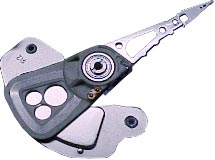Would you like to make this site your homepage? It's fast and easy...
Yes, Please make this my home page!
The main purpose of the Hard disk is to store files in a reliable, fast, and compact way while also providing a simple interface. It is quite fascinating how the hard disk can do so much work with a simple instruction such as saving a file. The hard disk has no idea what kind of data is being transferred and can not distinguish if a letter or number is being stored but manages to locate a specific cluster within millions of other clusters all within a millionth of a second.
The following is a basic overview of how the hard disk works which a must if you would like to know how data is stored and maintained.
|
|
The hard disk is composed up of three major sections which include the platter assembly, the actuator assembly, and main board.
The platter assembly is composed of a high-speed motor that is directly attached to aluminum platters that rotate at speeds up to and including 17,000 rpm. These platters are coated with a material that can be influenced by magnetic pulses and is not much different from your standard floppy disk. This is how the two got their name, the floppy disk has a plastic durable floppy platter while the hard disk has a stiff fragile aluminum platter.

The actuator assembly is composed up of multiple read /write heads that alter or get the information stored on the platter. The armature extends the heads out to where it needs to retrieve or store information. The armature is placed on a pivot that is connected to a voice coil motor that is composed up of a coil and a strong magnet. This actuator assembly is placed at an angle to the platters which also allows it to move anywhere on the platter in a fraction of a second.
This construction revolutionized the way hard disks were made because the voice coil is very fast and when power is lost, the motor connected to the platters acts like a generator and moves the voice coil so that the heads are placed in a safe zone. This is important because the platters are so sensitive that if you were to accidentally bump you computer when the heads were in the middle of the platter when power was off, you would develop a non-fixable defect which could eventually kill all the data an the platter.

The main board has the responsibility of interpreting the information coming from and to the platters and amplifying the signal to a usable amplitude, around 5 volts. It also has the circuitry required to calculate where the operating system wants the information to go.

|
|
| Heads, cylinders, sectors |
|
The heads setting is composed up of one side of a two sided platter, most hard disk have no more then 4 heads but certain limitations to the way the information is stored in the CMOS has led to some sneaky trickery to make things work right. This will be obvious when you look at your parameters and see a setting like 16 heads on a drive that only has a height of 1 inch.
Cylinder is composed up of tracks, tracks are thousands of magnetic rings on the platter that the heads are to read and write to. Since tracks are the same for each platter and platters are stacked upon each other, these tracks start to look like a cylinder or "tube like structures". This is why you might not see both track or cylinder settings on a hard disk at one time because the number is exactly the same.
Sectors break up the tracks so they look more like boxes that can store information Since these boxes are not labeled the main board calculates where the box is when the operating system tells it that it wants the file at head 1, track 5, sector 3. Since each sector has a specific number of informations it can store, the algorithm is shown.
|
|
Head = specifies which side if which platter to use
Sector = Which zone is the data in, much like how a analog clock is numbered but changes from disk to disk.
Track = Imaginary rings around the hard disk that specifies how far the heads on the actuator are to move towards the center of the platter.
Head * sector * track = location on hard disk accurate to the cluster.
Since Microsoft operating systems can only allocate clusters, the above equation will find a specific cluster but if you want to go any further then you will need to proceed.
8 bytes = 1 bit
512 bytes = 1 block
Head * track * sector * (blocks * 512) * 8 = number of bits of storage
|
|
Home |
Contact us |
Our History |
Link to us |
Relations
A Passion Production ©opyright 2000
